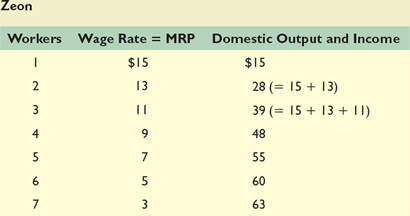Economics (McConnell), 18th EditionChapter 22:
ImmigrationKey Questions1. In what respect is the economic decision to move across international borders an investment decision? Why do economic migrants move to some countries, but not to others? Cite an example of an explicit cost of moving; an implicit cost of moving. How do distance and age affect the migration decision? How does the presence of a large number of previous movers to a country affect the projected costs and benefits of subsequent movers? 2. Use the accompanying table for Neon and Zeon to answer the questions that follow. Assume that the wage rate shown equals hourly output and income and that the accumulated output and income are the sum of the marginal revenue products (MRPs) of each worker.  <a onClick="window.open('/olcweb/cgi/pluginpop.cgi?it=jpg::::/sites/dl/free/0025694212/668730/Chap22_key1.jpg','popWin', 'width=NaN,height=NaN,resizable,scrollbars');" href="#"><img valign="absmiddle" height="16" width="16" border="0" src="/olcweb/styles/shared/linkicons/image.gif"> (34.0K)</a> <a onClick="window.open('/olcweb/cgi/pluginpop.cgi?it=jpg::::/sites/dl/free/0025694212/668730/Chap22_key1.jpg','popWin', 'width=NaN,height=NaN,resizable,scrollbars');" href="#"><img valign="absmiddle" height="16" width="16" border="0" src="/olcweb/styles/shared/linkicons/image.gif"> (34.0K)</a>
 <a onClick="window.open('/olcweb/cgi/pluginpop.cgi?it=jpg::::/sites/dl/free/0025694212/668730/Chap22_key2.jpg','popWin', 'width=NaN,height=NaN,resizable,scrollbars');" href="#"><img valign="absmiddle" height="16" width="16" border="0" src="/olcweb/styles/shared/linkicons/image.gif"> (33.0K)</a> <a onClick="window.open('/olcweb/cgi/pluginpop.cgi?it=jpg::::/sites/dl/free/0025694212/668730/Chap22_key2.jpg','popWin', 'width=NaN,height=NaN,resizable,scrollbars');" href="#"><img valign="absmiddle" height="16" width="16" border="0" src="/olcweb/styles/shared/linkicons/image.gif"> (33.0K)</a>
- Which country has the greater stock of capital and technological
prowess? How can you tell?
- Suppose the equilibrium wage rate is $19 in Neon and $7 in Zeon. What is the domestic output (= domestic income) in the two countries?
- Assuming zero migration costs and initial wage rates of $19 in Neon and $7 in Zeon, how many workers will move to Neon? Why will not more than that number of workers move to Neon?
- After the move of workers, what will the equilibrium wage rate be in each country? What will the domestic output be after the migration? What is the amount of
the combined gain in domestic output produced by the migration? Which country will gain output; which will lose output? How will the income of native-born workers be affected in each country?
3. How might the output and income gains from immigration shown by the simple immigration model be affected by (a) unemployment in the originating nation,
(b) remittances by immigrants to the home country, and (c) backflows of migrants to the home country? 4. Why is each of these statements somewhat misleading? (a) "Illegal immigrants take only jobs that no American wants." (b) "Deporting 100,000 illegal immigrants would create 100,000 job openings for Americans."  Chapter 22 Key Question Solutions
(54.0K) Chapter 22 Key Question Solutions
(54.0K)
 | 


















